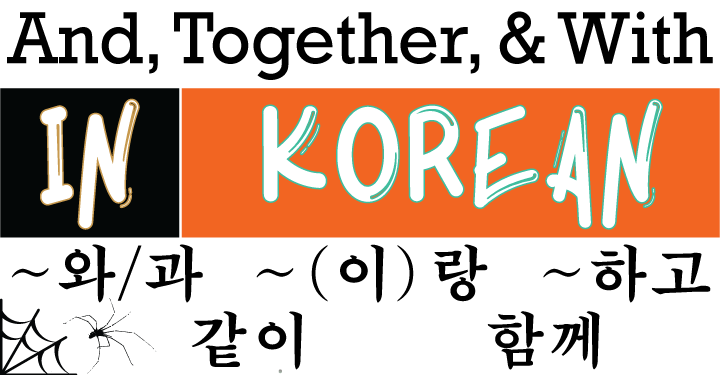3 Indispensable Words: And, Together, & With in Korean
The three indispensable words you will learn in this lesson are “And,” “Together,” & “With” in Korean. They are simple to learn yet extremely useful. Don’t forget to fill out the form at the end of this lesson to receive this lesson as a free PDF so you can study and review.
~와 & ~과 in Korean
~와 and ~과 are “And” and “With” in Korean. You should use ~와 and ~과 in written material and formal situations more often than common Korean conversation. Even if you are a beginner, you can easily tell if the meaning of “And” or “With” is being used through context.
Korean Particle ~와/~과 Grammar Structure
- Noun Ending in Consonant + 과
컵+ 과 = 컵과- 컵과 접시 = cup and plate
- Noun Ending in Vowel + 와
접시 + 와 = 접시와- 접시와 컵 = plate and cup
Sample Sentences “And” in Korean
| Korean | English |
| 토마스와 존 학교에 갔어요. | Thomas and John went to school. |
| 존과 토마스 학교에 갔어요. | John and Thomas went to school. |
Sample Sentences “With” in Korean
| Korean | English |
| 토마스는 존과 학교에 갔어요. | Thomas went to school with John. |
| 존은 토마스와 학교에 갔어요. | John went to school with Thomas. |
Did you notice how there isn’t a noun after ~과 or ~와 in these sentences? That is an easy way for you to know that ~와 and ~과 mean “With.”
~(이)랑 in Korean
~(이)랑 is “And” and “With” in Korean. You should use ~(이)랑 more often in common Korean conversation than written material and formal situations. Even if you are a beginner, you can easily tell if the meaning of “And” or “With” is being used through context.
Korean Particle ~(이)랑 Grammar Structure
- Noun Ending in Consonant + 이랑
컵+ 이랑 = 컵이랑- 컵이랑 접시 = cup and plate
- Noun Ending in Vowel + 랑
접시 + 랑 = 접시랑- 접시랑 컵 = plate and cup
Sample Sentences “And” in Korean
| Korean | English |
| 토마스랑 존 학교에 갔어요. | Thomas and John went to school. |
| 존이랑 토마스 학교에 갔어요. | John and Thomas went to school. |
Sample Sentences “With” in Korean
| Korean | English |
| 토마스는 존이랑 학교에 갔어요. | Thomas went to school with John. |
| 존은 토마스랑 학교에 갔어요. | John went to school with Thomas. |
| 누구랑 왔어요? | Who did you come with? |
Did you notice how there isn’t a noun after ~(이)랑 in these sentences? That is an easy way for you to know that ~(이)랑 means “With.”
[rad_rapidology_inline optin_id=”optin_2″]
~하고 in Korean
~하고 is “And” and “With” in Korean. ~하고 falls between ~와/과 and ~(이)랑 concerning formality. Even if you are a beginner, you can easily tell if the meaning of “And” or “With” is being used through context.
Korean Particle ~하고 Grammar Structure
Noun +하고
컵+ 하고 = 컵하고
컵하고 접시 = cup and plate
접시 + 하고 = 접시하고
접시하고 컵 = plate and cup
Sample Sentences “And” in Korean
| Korean | English |
| 토마스하고 존 학교에 갔어요. | Thomas and John went to school. |
| 존이하고 토마스 학교에 갔어요. | John and Thomas went to school. |
Sample Sentences “With” in Korean
| Korean | English |
| 토마스는 존하고 학교에 갔어요. | Thomas went to school with John. |
| 존은 토마스하고 학교에 갔어요. | John went to school with Thomas. |
| 누구하고 왔어요? | Who did you come with? |
Did you notice how there isn’t a noun after ~하고 in these sentences? That is an easy way for you to know that ~하고 means “With.”
같이 & 함께: Together in Korean
Sometimes Koreans say the word “Together” after “With” which makes the meaning very clear.
같이 is “Together” in Korean. You should use 캍이 more often in common Korean conversation than written material and formal situations.
Since 같이, ~(이)랑, and ~하고 are less formal they are used together.
함께 is “Together” in Korean too. You should use 함께 more often in written material and formal situations than common Korean conversation.
Since 함께 and ~와/과 are more formal they are used together.
Sample Sentences in Korean
| Korean | English |
| 토마스는 존하고 같이 학교에 갔어요. | Thomas went to school (together) with John. |
| 존은 토마스랑 같이 학교에 갔어요. | John went to school (together) with Thomas. |
| 누구랑 같이 왔어요? | Who did you come (together) with? |
| 누구하고 같이 왔어요? | Who did you come (together) with? |
| 토마스는 존과 함께 학교에 갔어요. | Thomas went to school (together) with John. |
[rad_rapidology_inline optin_id=”optin_2″]


Leave a Reply
You must be logged in to post a comment.